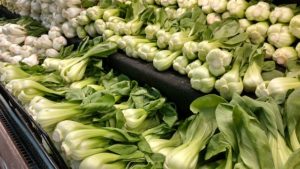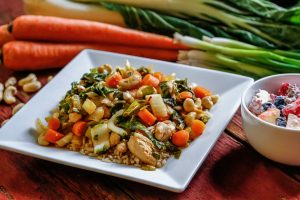Cooler temperatures have to be right around the corner…right?! As we transition into Fall, we want to help you take full advantage of some of the cooler-season produce. And, what better place to start than our September Superfood of the Month…
bok choy!
Have you wondered, what is bok choy?
 Different varieties! Bok choy can be found in many different varieties and goes by many different names including pak choy, white cabbage, Chinese chard, Chinese cabbage and many others. It’s a cruciferous vegetable, which means it is a powerful cancer-fighter, that has white to green stalks and dark green leaves.
Different varieties! Bok choy can be found in many different varieties and goes by many different names including pak choy, white cabbage, Chinese chard, Chinese cabbage and many others. It’s a cruciferous vegetable, which means it is a powerful cancer-fighter, that has white to green stalks and dark green leaves.
It grows in bunches and resembles romaine lettuce on the top and celery on the bottom. Bok choy likes to grow in cooler weather and many farmers will plant in late summer, meaning the next few months are a great time to enjoy it! Also, because it can withstand lower temperatures (even below 30 degrees), it is often available into the winter.
 Different sizes! Bok choy also comes in different sizes. Unless you go to an Asian grocery store, you are most likely to find “regular” bok choy or a smaller version called “baby” bok choy. There isn’t much difference between baby bok choy and the larger variety other than size…but, some say the baby bok choy is more tender.
Different sizes! Bok choy also comes in different sizes. Unless you go to an Asian grocery store, you are most likely to find “regular” bok choy or a smaller version called “baby” bok choy. There isn’t much difference between baby bok choy and the larger variety other than size…but, some say the baby bok choy is more tender.
Why we need to know about bok choy!
Bok choy originated in China and is known as the “Asian green.” Many Asian cultures believe food “should be treated as medicine” and bok choy does a great job nourishing our bodies. It’s high in beta carotene, which our bodies turn into Vitamin A. It’s also high in Vitamins C and K — actually, one cup provides 140% of our daily recommended Vitamin A and 70% of daily recommended Vitamin C…and one cup has less than 20 calories! It is also a good source of Omega-3, fiber, calcium and folate.
Believe it or not, bok choy has over 70 antioxidant substances and has been included in many studies to understand how antioxidants reduce our risk of cancer.
How do you choose it?
Another benefit of bok choy is it is super-affordable…you can typically pick up a large head for $3 or less. When picking bok choy, look for fresh, bright green leaves and crisp, pale white to green stalks. It’s best to use it as soon as possible, but it will store well in the refrigerator for several days. Before using it, you should clean it to wash out any dirt or grit that may be lodged in the leaves or stalks.
What can you do with bok choy?
 Bok choy has a mild and slightly sweet flavor and you should be enjoying both the tender leaves AND the crunchy stalks…they are both edible and delicious! We love the leafy and crisp crunch of bok choy, and it’s much more tender than red or green cabbage.
Bok choy has a mild and slightly sweet flavor and you should be enjoying both the tender leaves AND the crunchy stalks…they are both edible and delicious! We love the leafy and crisp crunch of bok choy, and it’s much more tender than red or green cabbage.
It’s fantastic to use in stir-fries, soups, side dishes and can also be eaten raw. Some people like the visual appeal of baby bok choy because you can cook it whole without breaking the leaves apart. While it is most often used in Asian dishes, it is very versatile and can be used with virtually any cuisine.
 If you haven’t enjoyed bok choy yet, or have already discovered it and would like some new ideas, here are some great places to start:
If you haven’t enjoyed bok choy yet, or have already discovered it and would like some new ideas, here are some great places to start:
Bok Choy Stir Fry
Grilled Bok Choy with Orange Vinaigrette
Kale and Bok Choy Bi Bim Bop
Cashew Chicken Bok Choy
Bok Choy Salad with Sesame Soy Dressing
Slow Cooker Chicken Pho
Take the Superfood Challenge for September!
Simply try one recipe each week using bok choy. We would love to hear about your experiences and successes!
For easy reference, here are the previous Superfoods of the Month:
January: Kale
February: Sweet Potatoes
March: Mango
April: Asparagus
May: Rhubarb
June: Beets
July: Peaches
August: Eggplant
 LEARN MORE ABOUT THE NAPKIN!
LEARN MORE ABOUT THE NAPKIN!
Leave A Comment